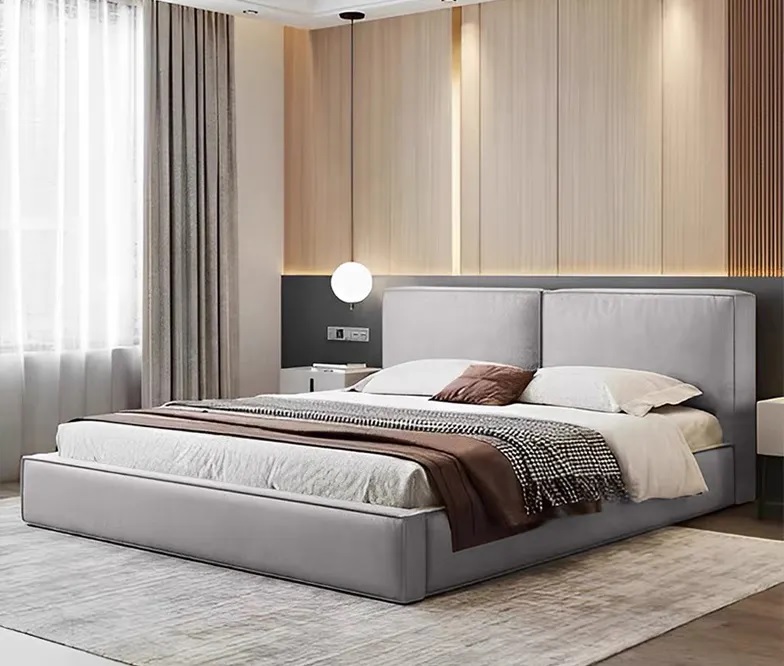When it comes to selecting a bed frame, there are various options available, each with its own set of pros and cons. One popular choice that has gained traction in recent years is the low bed frame.
Low bed frames, also known as platform beds or low-profile beds, have a distinctive minimalist design and sit closer to the ground compared to traditional bed frames. In this article, we will delve into the pros and cons of low bed frames, helping you make an informed decision when choosing the perfect bed frame for your needs.
Pros of a Low Bed Frame:
1.Easy Accessibility:
One of the main advantages of a low bed frame is the ease of access. The lower height makes it easier to get in and out of bed, particularly for individuals with mobility issues or those who prefer a seamless transition from the floor to the bed. This accessibility feature can be particularly beneficial for the elderly or people with disabilities.
2. Modern and Stylish Design:
Low bed frames offer a contemporary and sleek aesthetic, perfect for those who prefer a minimalist and modern look in their bedroom. The clean lines and simplicity of a low bed frame can contribute to an overall sense of tranquillity and spaciousness in the room.
3. Space-Saving Solution:
If you have a smaller bedroom or limited space, a low bed frame can be a practical choice. Due to their low height, these bed frames create an illusion of more space in the room, making it appear larger and less cluttered. Additionally, the absence of a bulky headboard or footboard allows for more flexibility in arranging furniture and maximises the available space.
4. Comfortable and Supportive:
Low bed frames often come with a solid platform or slats as a base for the mattress. This provides a stable foundation that can contribute to better mattress support, which is essential for a good night’s sleep. Furthermore, the lower profile can create a cosier and more intimate sleeping environment.
5. Versatility in Mattress Choices:
Low bed frames can accommodate various types of mattresses, including memory foam, latex, or hybrid mattresses. The absence of a high bed frame or box spring allows for more flexibility in choosing the right mattress thickness and material. This versatility ensures that you can select a mattress that suits your comfort preferences and sleep needs.
6. Child and Pet Friendly:
The lower height of a low bed frame makes it easier for children or smaller pets to climb on and off the bed safely. This can be particularly useful for families with young children or pets who love to snuggle up on the bed. The reduced risk of falling or jumping from a high bed frame promotes a safer sleeping environment for both kids and pets.
7. Easy Maintenance:
Cleaning and maintaining a low bed frame is generally easier compared to taller bed frames. Since the frame is closer to the ground, it eliminates the need for frequent dusting or vacuuming underneath the bed. Additionally, changing bed sheets or flipping the mattress becomes less strenuous, making routine maintenance tasks more convenient and hassle-free.
8. Ideal for Minimalist Décor:
Low bed frames complement minimalist interior design styles, where simplicity and functionality take precedence. Their understated presence can create a sense of serenity and harmony in a bedroom. By opting for a low bed frame, you can maintain a streamlined and clutter-free aesthetic, allowing other design elements to shine.
9. Cost-Effective:
In general, low bed frames tend to be more affordable compared to larger or more elaborate bed frames. Their simpler construction and reduced material requirements often result in lower price points. This cost-effectiveness can be advantageous for budget-conscious individuals or those seeking a practical and straightforward sleeping solution without breaking the bank.
Cons of a Low Bed Frame:
1. Limited Under-Bed Storage:
While the low height of the bed frame can be advantageous in terms of accessibility and space-saving, it also comes with a trade-off. Low bed frames typically offer limited under-bed storage space compared to traditional bed frames with higher clearance. This can be a drawback for those who require additional storage for bedding, seasonal clothes, or other items.
2. Cleaning Challenges:
Another consideration with low bed frames is the potential difficulty in cleaning and maintenance. With the mattress being closer to the floor, dust and dirt can accumulate more easily. Regular vacuuming and cleaning of the floor area under the bed become crucial to maintain cleanliness and hygiene.
3. Cooling and Ventilation:
The lower height of a low bed frame can impact the air circulation around the mattress. Adequate airflow is important for keeping the mattress fresh and preventing the buildup of moisture and mould. If you live in a humid climate or have concerns about ventilation, a low bed frame may not be the ideal choice.
4. Limited Accessibility for Some Individuals:
While the low height of a bed frame can be advantageous for many people, it may pose difficulties for others, especially those with mobility issues or physical limitations. Getting in and out of a low bed can be challenging for individuals with knee or back problems, as it requires more effort and can strain their muscles and joints.
5. Incompatibility with Certain Mattress Types:
Low bed frames may not be suitable for all types of mattresses. Some mattresses, such as those with a significant thickness or specific features like built-in pillow tops or extra layers, may not be compatible with low bed frames. This can limit your options when selecting a mattress that fits your preferences and needs.
6. Difficulty in Getting Up:
Getting up from a low bed frame can be more challenging, especially for individuals with limited strength or flexibility. The lower height can make it harder to push off and rise from the bed, potentially causing inconvenience or discomfort, particularly in the mornings or for those with certain medical conditions.
7. Reduced Under-Bed Air Circulation:
In addition to impacting mattress ventilation, low bed frames can also limit the air circulation under the bed. This can affect the overall freshness of the bedroom and potentially lead to the accumulation of dust or allergens. It is important to consider the implications for air quality and take appropriate measures to maintain a clean and healthy sleeping environment.
FAQs
1. Are low bed frames suitable for all mattress types?
Yes, low bed frames are compatible with various mattress types, including memory foam, latex, innerspring, and hybrid mattresses. However, it’s important to ensure that the mattress chosen is of appropriate thickness to provide adequate comfort and support.
2. Can I add a headboard to a low bed frame?
Many low bed frames come with the option to add a headboard. However, it’s essential to check the compatibility and design of the headboard with the specific low bed frame you choose. Some low bed frames may have pre-drilled holes or attachment mechanisms to easily install a headboard, while others may require additional modifications.
3. Are low bed frames sturdy and durable?
Low bed frames can be as sturdy and durable as traditional bed frames. It’s important to select a high-quality low bed frame made from durable materials, such as solid wood or metal, to ensure long-lasting support. Checking customer reviews and product specifications can help you gauge the durability of a particular low bed frame.
4. Can I use a low bed frame with a box spring?
Most low bed frames are designed to be used without a box spring. The solid platform or slats provided with the bed frame offer sufficient support for the mattress. However, if you prefer the added height and extra cushioning provided by a box spring, you can opt for a low bed frame that is compatible with it.
Summary
Low bed frames offer a range of benefits, including easy accessibility, modern design, space-saving advantages, and improved mattress support. However, it’s essential to consider the potential drawbacks, such as limited under-bed storage and cleaning challenges. Before purchasing a low bed frame, assess your specific needs, available space, and personal preferences.
By weighing the pros and cons discussed in this article, you can make an informed decision and select a bed frame in Malaysia that suits your requirements. Whether you prioritise style, functionality, or a combination of both, a low bed frame can be an excellent choice for creating a contemporary and comfortable bedroom.


